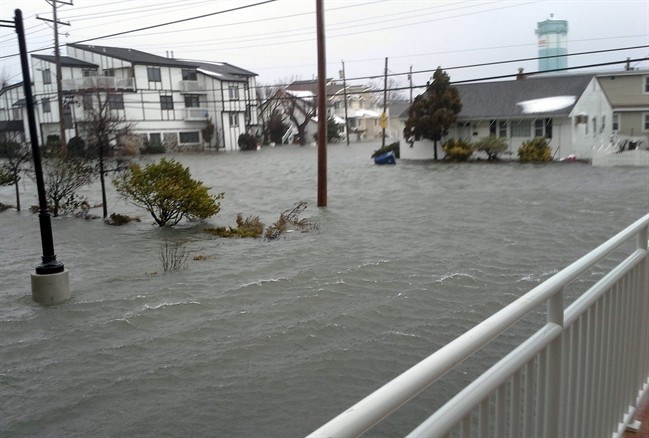
Wind-blown snow buries vehicles, Sunday, Jan. 24, 2016, in Parkville, Md. Millions of Americans are digging themselves out Sunday after a mammoth blizzard with hurricane-force winds and record-setting snowfall brought much of the East Coast to an icy standstill.
Image Credit: AP Photo/Steve Ruark
January 24, 2016 - 10:30 AM
NEW YORK, N.Y. - Millions of Americans began digging out Sunday from a mammoth blizzard that set a new single-day snowfall record in Washington and New York City. The hurricane-force winds and whiteout conditions gave way to blinding sunshine and temperatures slightly above freezing, promising a gentle thawing-out.
The timing could not have been better for East Coast states: The heaviest snow began falling Friday evening, and tapered off just before midnight Saturday. Millions heeded calls to stay home, enabling road crews to clear snow and ice.
New York and Baltimore began lifting travel restrictions and hearty souls ventured out on snow-choked streets, while mass transit systems up and down the coast gradually restored normal service.
Crews were working to restore power in places around the region and flooding remained a problem along the coast, but as predicted, the impact was nothing like Superstorm Sandy in 2012.
The air travel picture remained complicated after 7,000 weekend flights were cancelled: United Airlines said limited service might begin later Sunday in New York City, but airports in the Washington D.C. area were likely to remain closed Sunday, and other airlines began cutting Monday service.
The massive snowstorm brought both Washington, D.C., and New York to a stop, dumping as much as 3 feet (90 centimetres) of snow and stranding tens of thousands of travellers. At least 18 deaths were blamed on the weather, resulting from car crashes, shovelling snow and hypothermia.
In New York, the storm dropped 26.8 inches (68.1 centimetres) in Central Park, the second-most recorded since 1869 and just short of the record 26.9 inches (68.3 centimetres) set in February 2006. The 26.6 inches (67.6 centimetres) that fell on Saturday, however, was the city's record for a single day. At Washington's National Zoo, 22.4 inches (56.9 centimetres) fell, beating the 21 inches (53.3 centimetres) that fell on Jan. 28, 1922.
The storm dropped snow from the Gulf Coast to the northeastern New England states, with areas of Washington surpassing 30 inches (75 centimetres). The heaviest official report was 42 inches (107 centimetres), in Glengary, West Virginia.
The usually bustling New York City looked more like a ghost town. With Broadway shows dark, thin crowds shuffled through a different kind of Great White Way, the nickname for a section of the theatre district, but shows were given the green light to resume performances Sunday. Bruce Springsteen cancelled Sunday's scheduled show at Madison Square Garden.
The travel ban that barred nonemergency vehicles from the roads of New York City was lifted at 7 a.m. Sunday by Gov. Andrew Cuomo. In Baltimore, a travel ban was also lifted, but some restrictions remain in place.
In Washington, monuments that would typically be busy with tourists stood vacant. All mass transit in the capital was shut down through Sunday. In northern Virginia, plow trucks outnumbered passenger vehicles on the streets Sunday.

Coastal flooding from a winter snowstorm inundates houses along New York Avenue, Saturday, Jan. 23, 2016, in North Wildwood, N.J.
Image Credit: AP Photo/Robb Nunzio
Travel conditions were improving from the dangerously snowy, icy roads that led to crashes that killed several people Friday and Saturday. Those killed included a 4-year-old boy in North Carolina; a Kentucky transportation worker who was plowing highways; and a woman whose car plunged down a 300-foot (90-meter) embankment in Tennessee. Three people died while shovelling snow in New York City.
An Ohio teenager sledding behind an all-terrain vehicle was hit by a truck and killed, and two people died of hypothermia in southwest Virginia. In North Carolina, a man whose car had veered off an icy-covered road was arrested on charges of killing one of three men who stopped to help.
In Kentucky, Pennsylvania and West Virginia, drivers were marooned for hours on snow-choked highways. Roofs collapsed on a historic theatre in Virginia and a horse barn in Maryland.
The snow was whipped into a maelstrom by winds that reached 75 mph (120 kph) at Dewey Beach, Delaware, and Langley Air Force Base, Virginia, the weather service said. From Virginia to New York, sustained winds topped 30 mph (48 kph) and gusted to around 50 mph (80 kph). And if that weren't enough, the storm also had bursts of thunder and lightning.
Stranded travellers included Defence Secretary Ash Carter, whose high-tech aircraft, the Doomsday Plane, couldn't land at Andrews Air Force Base in Maryland after returning from Europe. Carter was rerouted to Tampa, Florida.
___
Borenstein reported from Washington. Contributors include Associated Press writers William Mathis, Scott Mayerowitz and Jake Pearson in New York; Alex Brandon and Lolita C. Baldor in Washington; Jessica Gresko in Arlington, Virginia; Ben Nuckols in Burke, Virginia; Juliet Linderman in Baltimore; Adrian Sainz in Memphis, Tennessee; Claire Garofalo in Louisville, Kentucky; John Raby in Charleston, West Virginia; and Bob Lentz in Philadelphia.
News from © The Associated Press, 2016